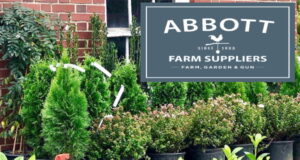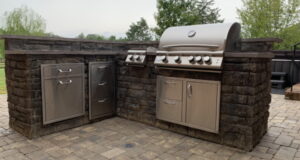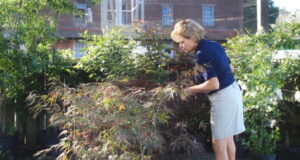A Soggy Scenario
By Bart Streb
 As I sit here on this rain-soaked Saturday my mind wanders back when I owned homes built in 1960, 1978 and 1993. Rain-filled seasons like we have had always remind me of the fear and worry I had dealing with moisture issues in those dated homes. I remember rain soaking into window frames, into siding and seeing a torrent pouring out from crawlspaces. In my 30+ years of inspecting and working on properties, water damage is probably the largest maintenance issue I have noticed on homes. But travel forward to today, in my 3-year-old, sealed crawlspace, fibercement and vinyl window home, I rest with very few worries of past concerns. Time for another cup of coffee.
As I sit here on this rain-soaked Saturday my mind wanders back when I owned homes built in 1960, 1978 and 1993. Rain-filled seasons like we have had always remind me of the fear and worry I had dealing with moisture issues in those dated homes. I remember rain soaking into window frames, into siding and seeing a torrent pouring out from crawlspaces. In my 30+ years of inspecting and working on properties, water damage is probably the largest maintenance issue I have noticed on homes. But travel forward to today, in my 3-year-old, sealed crawlspace, fibercement and vinyl window home, I rest with very few worries of past concerns. Time for another cup of coffee.
Start from the top....
 Your roof guttering is the front line in rainwater removal. I have seen gutters with leaves so rotten that it appeared as dirt upon removal. And the plants growing there? A gutter garden of sorts. It is very important to have your guttering system remove the water from your roofline as water will pour in behind clogged gutters, onto your roof framing (the soffit and fascia) with the gutters acting as a nice water retention surface. To remove gutters and replace rotten trim boards is more expensive than having gutters cleaned. Telltale signs of rot are dark areas on the trim or boards that tend to look cracked (which is actually dry rot working on the wood). Of course, the small mushroom fungi growing under the gutter should alarm you too. Once wood is soft from rot, birds, insects and rodents will work away on it. They love the soft wood and waste no time opening up some crevices for their use. Gutter cleaning is one of the most dangerous home maintenance chores so be extra careful or hire it out.
Your roof guttering is the front line in rainwater removal. I have seen gutters with leaves so rotten that it appeared as dirt upon removal. And the plants growing there? A gutter garden of sorts. It is very important to have your guttering system remove the water from your roofline as water will pour in behind clogged gutters, onto your roof framing (the soffit and fascia) with the gutters acting as a nice water retention surface. To remove gutters and replace rotten trim boards is more expensive than having gutters cleaned. Telltale signs of rot are dark areas on the trim or boards that tend to look cracked (which is actually dry rot working on the wood). Of course, the small mushroom fungi growing under the gutter should alarm you too. Once wood is soft from rot, birds, insects and rodents will work away on it. They love the soft wood and waste no time opening up some crevices for their use. Gutter cleaning is one of the most dangerous home maintenance chores so be extra careful or hire it out.
Working our way down....
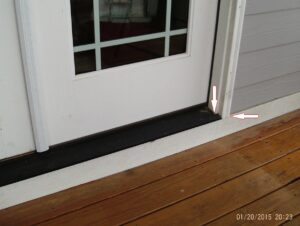 Next catch basins for rain are windows, door framing and siding (WDS). Even the most perfectly clean and functional guttering systems will do nothing for driving rain that contacts the home below the gutters. This water travels down the walls and will pool up where spots are available. Most damage I have seen are homes built from the late 1980's to the mid 2000's as the EPA outlawed certain chemicals in window framing that worked as a preservative to the wood, extending its life even with poor maintenance. Water has a magical capillary action when traveling. It will enter a crack and invite more of its molecular friends to join them. WDS that have exposed cracks from lack of paint or caulking create gateways to the soft, usually pine wood behind the weathered sealant. Be sure to inspect all joints in your WDS features for cracks or soft areas. Dry rot will eat away at the structural integrity of the wood, leaving voids and shrinking the wood around the WDS. Even if you can't handle repairs now, caulk the joints with a latex product (for future painting). If you haven't had the house painted in over 4 years, you need to inspect the caulking. I am amazed at the lack of painting some properties receive. If you stop the water intrusion now you will lessen the damage, but dry rot will keep working even if sealed. It can live off moisture in the air. Repairs will become more intensive (and expensive) as the rot works through to underlying framing so don't put off repairs. I can usually fix small spots with epoxy or wooden plugs. Large rot areas require removal of infected trim and siding and worse case, removal of entire WDS components. (edit-this would be a good place for pictures showing trouble spots to inspect).
Next catch basins for rain are windows, door framing and siding (WDS). Even the most perfectly clean and functional guttering systems will do nothing for driving rain that contacts the home below the gutters. This water travels down the walls and will pool up where spots are available. Most damage I have seen are homes built from the late 1980's to the mid 2000's as the EPA outlawed certain chemicals in window framing that worked as a preservative to the wood, extending its life even with poor maintenance. Water has a magical capillary action when traveling. It will enter a crack and invite more of its molecular friends to join them. WDS that have exposed cracks from lack of paint or caulking create gateways to the soft, usually pine wood behind the weathered sealant. Be sure to inspect all joints in your WDS features for cracks or soft areas. Dry rot will eat away at the structural integrity of the wood, leaving voids and shrinking the wood around the WDS. Even if you can't handle repairs now, caulk the joints with a latex product (for future painting). If you haven't had the house painted in over 4 years, you need to inspect the caulking. I am amazed at the lack of painting some properties receive. If you stop the water intrusion now you will lessen the damage, but dry rot will keep working even if sealed. It can live off moisture in the air. Repairs will become more intensive (and expensive) as the rot works through to underlying framing so don't put off repairs. I can usually fix small spots with epoxy or wooden plugs. Large rot areas require removal of infected trim and siding and worse case, removal of entire WDS components. (edit-this would be a good place for pictures showing trouble spots to inspect).
Take a Peek in the Crawlspace
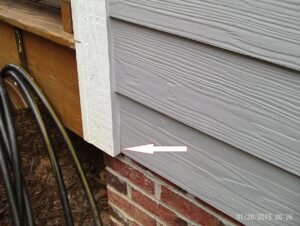 Your crawlspace is a very important organ of your living home. It is not an area to be ignored and untended as air quality for the rest of the home starts here and this area can produce some of the most dangerous conditions in your dwelling. Routinely go in there. Yes, it is dirty, and creepy, and dark, and there may be some critters crawling on more than 4 legs but it is your crawlspace. Own it! Or hire someone to do a quick peek in there. Be careful of pest inspectors that will check it for you and then offer a "Host" of Remedies" for your problems as they get paid to find work. I have seen them take advantage of a homeowner more than once. A third party, objective pair of eyes is better. If you do it yourself, look for any moisture. You should have plastic sheeting on the floor, period. This is paramount as our clay soils hold vast amounts of moisture. Moisture from the soil evaporates and lands on any surface. Look for sweaty ductwork or air handlers. Moisture on wood framing or insulation batts usually is absorbed and will leave dark speckles of microbial growth. Animal droppings are a sign you are running a critter BNB so find out where they are getting in. Rule of thumb is, the bigger the access the bigger the critter and the bigger the droppings! Insect infestations can be taken care of with insecticide products. Just be on the lookout for black speckles, any standing water, insects or droppings. I have been in some crawlspaces that were so bad, I had to run to the van, tires squealing out of the driveway (well, not really but I referred the job to mold remediation companies that charge excessive $$$).
Your crawlspace is a very important organ of your living home. It is not an area to be ignored and untended as air quality for the rest of the home starts here and this area can produce some of the most dangerous conditions in your dwelling. Routinely go in there. Yes, it is dirty, and creepy, and dark, and there may be some critters crawling on more than 4 legs but it is your crawlspace. Own it! Or hire someone to do a quick peek in there. Be careful of pest inspectors that will check it for you and then offer a "Host" of Remedies" for your problems as they get paid to find work. I have seen them take advantage of a homeowner more than once. A third party, objective pair of eyes is better. If you do it yourself, look for any moisture. You should have plastic sheeting on the floor, period. This is paramount as our clay soils hold vast amounts of moisture. Moisture from the soil evaporates and lands on any surface. Look for sweaty ductwork or air handlers. Moisture on wood framing or insulation batts usually is absorbed and will leave dark speckles of microbial growth. Animal droppings are a sign you are running a critter BNB so find out where they are getting in. Rule of thumb is, the bigger the access the bigger the critter and the bigger the droppings! Insect infestations can be taken care of with insecticide products. Just be on the lookout for black speckles, any standing water, insects or droppings. I have been in some crawlspaces that were so bad, I had to run to the van, tires squealing out of the driveway (well, not really but I referred the job to mold remediation companies that charge excessive $$$).
Onto Your Garden (or Your Grounds)...
 The last stop for water before it leaves well enough alone is the area around your foundation wall. A properly sloped yard will pull water away from the foundation and have some sort of depression, or swale to carry it away. Any low spots next to the wall should be filled and a grade maintained. Guttering should extend at least a few feet from the wall. Any condensation lines (usually white PVC pipe coming through the brick) that carry condensate from your air handler should be extended also. I am not a big fan of deep mulch against foundations. If that is your thing, rethink it. I have seen years of rotten mulch create pockets of moisture so I put a small barrier of pebbles around my wall with some landscape fabric below it. It gives me piece of mind that any termites or moisture will have a hard time without the convenient travel path of several inches of rotten mulch deposited over years.
The last stop for water before it leaves well enough alone is the area around your foundation wall. A properly sloped yard will pull water away from the foundation and have some sort of depression, or swale to carry it away. Any low spots next to the wall should be filled and a grade maintained. Guttering should extend at least a few feet from the wall. Any condensation lines (usually white PVC pipe coming through the brick) that carry condensate from your air handler should be extended also. I am not a big fan of deep mulch against foundations. If that is your thing, rethink it. I have seen years of rotten mulch create pockets of moisture so I put a small barrier of pebbles around my wall with some landscape fabric below it. It gives me piece of mind that any termites or moisture will have a hard time without the convenient travel path of several inches of rotten mulch deposited over years.
In summary, water damage can be avoided by some simple and relatively easy steps. If you see rainwater pouring out of your gutters, you have a problem. If you see open cracks or soft wood in your WDS joints, there is a problem. If you find black speckles, standing water or sweaty ductwork in your crawlspace, another problem. Water standing next to your foundation or excessive rotten mulch, more problems. Your home is one of your largest investments in life so take care of it and keep her healthy!
Bart Streb is owner of Real Estate Repair and Restoration providing repairs and maintenance to Hyco and Mayo Lake area homes. | https://www.linkedin.com/in/bartstreb | (919) 971 0177 ![]()
 Happy Endings Publications Hyco Lake, River City Area & SoBo Halifax Magazines
Happy Endings Publications Hyco Lake, River City Area & SoBo Halifax Magazines
